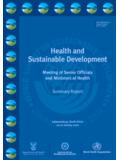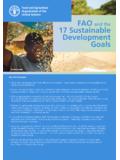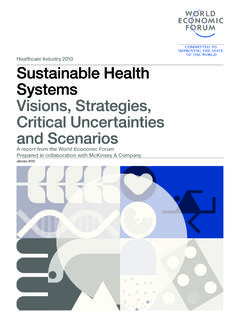Transcription of REGIONAL COMMITTEE FOR EUROPE 66 th …
1 Plan for sexual and reproductive health : towards achieving the 2030 Agenda for sustainable development in EUROPE leaving no one behindWorking documentREGIONAL COMMITTEE FOR EUROPE 66th SESSIONC openhagen, Denmark, 12 15 September 2016 WORLD health ORGANIZATION REGIONAL OFFICE FOR EUROPE UN City, Marmorvej 51, DK-2100 Copenhagen , Denmark Telephone: +45 45 33 70 00 Fax: +45 45 33 70 01 Email: Web: REGIONAL COMMITTEE for EUROPE EUR/RC66/13 66th session +EUR/RC66 Copenhagen, Denmark, 12 15 September 2016 1 August 2016 160524 Provisional agenda item 5(i) ORIGINAL: ENGLISH Action plan for sexual and reproductive health : towards achieving the 2030 Agenda for sustainable development in EUROPE leaving no one behind The proposed Action plan for sexual and reproductive health : towards achieving the 2030 Agenda for sustainable development in EUROPE leaving no one behind is intended to accelerate progress towards improving sexual and reproductive health in line with the European health and well-being policy framework, health 2020, and the Minsk Declaration: the life-course approach in the context of health 2020.
2 The Action plan focuses on priority action areas and interventions to help Member States achieve the full potential for sexual and reproductive health and well-being for all people. The Action plan has been developed through a consultative process, guided by the Twenty-third Standing COMMITTEE of the WHO REGIONAL COMMITTEE for EUROPE and technical experts. It has been elaborated in line with the 2030 Agenda for sustainable development . EUR/RC66/13 page 2 Contents page Background and rationale .. 4 Guiding principles .. 6 Scope .. 7 Target audiences .. 7 Structure .. 8 Vision .. 8 Strategic directions .. 9 Goals, objectives and key actions .. 9 Goal 1: Enable all people to make informed decisions about their sexual and reproductive health and ensure that their human rights are respected, protected and fulfilled.. 9 Objective : Ensure that people s human rights related to sexuality and reproduction are respected, protected and fulfilled.
3 9 Objective : Establish and strengthen formal and informal evidence-informed comprehensive sexuality education.. 10 Objective : Provide information and services that enable people to make informed decisions about their sexual and reproductive health .. 10 Objective : Prevent intimate partner violence and non-partner sexual violence and exploitation, and provide victim support and help to perpetrators.. 11 Goal 2: Ensure that all people can enjoy the highest attainable standard of sexual and reproductive health and 12 Objective : Attend to all people s needs or concerns in relation to sexuality and sexual and reproductive health and rights.. 12 Objective : Reduce unmet need for contraception.. 12 Objective : Eliminate avoidable maternal and perinatal mortality and morbidity.. 13 Objective : Reduce sexually transmitted infections (STIs).. 14 Objective : Prevent, diagnose and treat infertility.
4 14 Objective : Establish and strengthen programmes for the prevention, diagnosis and treatment of reproductive cancers.. 15 Goal 3: Guarantee universal access to sexual and reproductive health and eliminate inequities.. 15 Objective : Expand the scope and reach of sexual and reproductive health services for adolescents.. 15 Objective : Establish and strengthen access to sexual and reproductive health services for population groups with specific needs.. 16 EUR/RC66/13 page 3 Objective : Integrate sexual and reproductive health into national public health strategies and programmes.. 17 Objective : Develop whole-of-government and whole-of-society approaches for effective and equitable implementation of programmes.. 17 Implementation .. 18 The role of the health ministry .. 18 The role of the WHO REGIONAL Office for EUROPE .. 18 The role of nongovernmental partners.
5 19 Monitoring and evaluation .. 19 References .. 20 Annex 1. Selected WHO global and REGIONAL strategies relevant to the Action plan for sexual and reproductive health : towards achieving the 2030 Agenda for sustainable development in EUROPE leaving no one behind .. 24 Annex 2. Explanatory 25 EUR/RC66/13 page 4 Background and rationale 1. The International Conference on Population and development (ICPD), held in Cairo, Egypt, in 1994, and its resulting Programme of Action, moved population policies and programmes away from a focus on human numbers to a focus on human rights and underscored the mutually reinforcing linkages between population and development . It recognized that reproductive health , including sexual health , and reproductive rights, as well as gender equality and women s empowerment, are important ends in themselves and key to improving the quality of life for everyone (1).
6 The Fourth World Conference on Women, held in Beijing, China, in 1995, reaffirmed those sentiments with the adoption of the Beijing Declaration and Platform for Action (2). 2. In the years that followed the ICPD, many countries and organizations around the world used the Programme of Action as a template for elaborating their own sexual and reproductive health strategies and action plans. Similarly, in the WHO European Region, a REGIONAL strategy on sexual and reproductive health (3), published in 2001, has been used by many Member States in the Region to formulate their national policy documents. The global reproductive health strategy (4) was adopted by WHO Member States at the Fifty-seventh World health Assembly in May 2004. 3. Although progress has been made over the past 20 years, many challenges remain to fully implement the outcomes of the Cairo and Beijing meetings and their review conferences.
7 Millennium development Goal 4 Reduce child mortality and Goal 5 Improve maternal health have still not been attained in many countries in the WHO European Region (5). 4. The 21st century health landscape is shaped by growing global, REGIONAL , national and local interdependence, in which all countries are challenged by major social, economic, environmental and demographic shifts. Significant inequalities in health remain, and in many places are worsening. Moreover, health policy-makers often lack the authority and tools to lead a coherent, integrated approach to these important challenges. For these and other reasons a wide-ranging process of research, dialogue and political commitment was undertaken in the WHO European Region, which led to the adoption by all 53 European Member States of the European policy framework for health and well-being, health 2020 (6), in resolution EUR/RC62/R4 in 2012.
8 health 2020 aims to support action across government and society to significantly improve the health and well-being of populations, reduce health inequalities, strengthen public health and ensure people-centred health systems that are universal, equitable, sustainable and of high quality . 5. By adopting the 2030 Agenda for sustainable development (7,8) and the related sustainable development Goals (SDGs), United Nations Member States have confirmed their commitment to SDG Target to ensure universal access to sexual and reproductive health care services, including for family planning, information and education, and the integration of reproductive health into national strategies and programmes by 2030 and to SDG Target to ensure universal access to sexual and reproductive health and reproductive rights as agreed in accordance with the ICPD Programme of Action and the Beijing Platform for Action and the outcome documents of their review conferences.
9 SDG10 reducing inequalities within and among EUR/RC66/13 page 5 countries is crucial for further improvement of sexual and reproductive health . New evidence and recently approved global and REGIONAL strategies indicate the need to develop a new European action plan for sexual and reproductive health and 6. The Global Strategy for Women s, Children s and Adolescents health (2016 2030) (9) provides guidance to accelerate momentum for women s, children s and adolescents health within the overall framework of the SDGs. The Global Strategy takes a life-course, gender-based approach and views women s, children s and adolescents health from an integrated and multisectoral perspective. 7. The Action plan for sexual and reproductive health : towards achieving the 2030 Agenda for sustainable development in EUROPE leaving no one behind reflects the objectives and main policy directions of health 2020 and other relevant global and REGIONAL strategies and action plans that have been adopted in recent years (see References and Annex 1).
10 8. Over the past 15 years, many Member States in the European Region have made substantial progress in improving several key sexual and reproductive health indicators. For instance, the average perinatal mortality rate for the European Region declined by nearly a quarter from perinatal deaths per 1000 births in 2000 to fewer than in 2013; the average estimated maternal mortality ratio decreased by more than half from 33 maternal deaths per 100 000 live births in 2000 to 16 in 2015. 9. The contraceptive prevalence rate, using modern methods, increased slightly from in 2000 to in 2015, mostly as a result of increases in eastern and southern EUROPE (10). The abortion ratio in the European Region has fallen from 431 abortions to 1000 live births in 2000 to 234 in 2013. 10. Progress has also been made in reducing the incidence of syphilis (from a REGIONAL average of per 100 000 population in 2000 to in 2011) and gonococcal infections (from in 2000 to in 2011) but HIV incidence has nearly doubled (from in 2000 to in 2013).

















